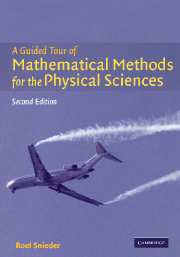Book contents
- Frontmatter
- Contents
- Preface to Second Edition
- Acknowledgements
- 1 Introduction
- 2 Dimensional analysis
- 3 Power series
- 4 Spherical and cylindrical coordinates
- 5 Gradient
- 6 Divergence of a vector field
- 7 Curl of a vector field
- 8 Theorem of Gauss
- 9 Theorem of Stokes
- 10 Laplacian
- 11 Conservation laws
- 12 Scale analysis
- 13 Linear algebra
- 14 Dirac delta function
- 15 Fourier analysis
- 16 Analytic functions
- 17 Complex integration
- 18 Green's functions: principles
- 19 Green's functions: examples
- 20 Normal modes
- 21 Potential theory
- 22 Cartesian tensors
- 23 Perturbation theory
- 24 Asymptotic evaluation of integrals
- 25 Variational calculus
- 26 Epilogue, on power and knowledge
- References
- Index
20 - Normal modes
Published online by Cambridge University Press: 05 June 2012
- Frontmatter
- Contents
- Preface to Second Edition
- Acknowledgements
- 1 Introduction
- 2 Dimensional analysis
- 3 Power series
- 4 Spherical and cylindrical coordinates
- 5 Gradient
- 6 Divergence of a vector field
- 7 Curl of a vector field
- 8 Theorem of Gauss
- 9 Theorem of Stokes
- 10 Laplacian
- 11 Conservation laws
- 12 Scale analysis
- 13 Linear algebra
- 14 Dirac delta function
- 15 Fourier analysis
- 16 Analytic functions
- 17 Complex integration
- 18 Green's functions: principles
- 19 Green's functions: examples
- 20 Normal modes
- 21 Potential theory
- 22 Cartesian tensors
- 23 Perturbation theory
- 24 Asymptotic evaluation of integrals
- 25 Variational calculus
- 26 Epilogue, on power and knowledge
- References
- Index
Summary
Many physical systems have the property that they can carry out oscillations at certain specific frequencies only. As a child (and hopefully also as an adult) you will have discovered that a swing in a playground will move only with a specific natural period, and that the force that pushes the swing is only effective when the period of the force matches the period of the swing. The patterns of motion at which a system oscillates are called the normal modes of the system. A swing has one normal mode, but you have seen in Section 13.6 that a simple model of a tri-atomic molecule has three normal modes. An example of a normal mode of a system is given in Figure 20.1 which shows the pattern of oscillation of a metal plate which is driven by an oscillator at a fixed frequency. The screw in the middle of the plate shows the point at which the force on the plate is applied. Sand is sprinkled on the plate. When the frequency of the external force is equal to the frequency of a normal mode of the plate, the motion of the plate is given by the motion that corresponds to that specific normal mode. Such a pattern of oscillation has nodal lines where the motion vanishes. These nodal lines are visible because the sand on the plate collects at these lines.
- Type
- Chapter
- Information
- A Guided Tour of Mathematical MethodsFor the Physical Sciences, pp. 311 - 352Publisher: Cambridge University PressPrint publication year: 2004



